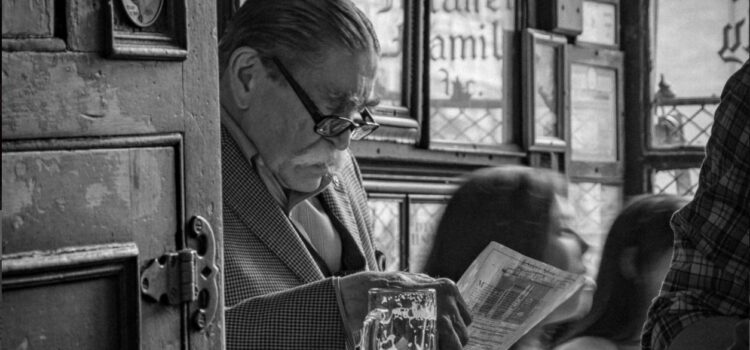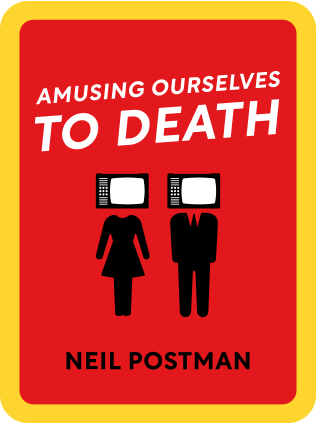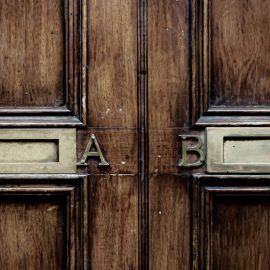

This article is an excerpt from the Shortform book guide to "Amusing Ourselves to Death" by Neil Postman. Shortform has the world's best summaries and analyses of books you should be reading.
Like this article? Sign up for a free trial here .
How did the print culture of previous centuries differ from the entertainment and media culture of today? How has our approach to media consumption changed over the years?
The print-centered discourse of 18th and 19th century America was rational, substantive, and serious. In comparison, the entertainment culture of today is shallow, prioritizing entertainment over intelligence.
Here’s how the age of print culture differed from our current-day society.
The History of Print Culture
To understand just how much television has changed the way we think and talk, it’s necessary to contrast today’s shallow entertainment culture with the serious, rational print culture that shaped America from the colonists’ arrival in the New World through the 19th century.
In that era, print structured public discourse, influenced its content, and appealed to and required a certain kind of audience—one skilled at reading and thinking.
The colonists were avid readers, particularly of the Bible, but they brought many books with them from England and had others imported.
The literacy rate for all social classes was high. For instance, in Massachusetts and Connecticut in 1640-1700, the rate for men was between 89% and 95%. For women between 1681-1697, it was as high as 62%.
Religion (being able to read the Bible) was a driving factor. In addition, immigrants to New England came from more literate parts of the Old World, or were a more literate demographic. Further, most New England towns required a “reading and writing school”; larger ones required a grammar school also. Reading influenced political, religious, and social life.
The Centrality of Reading
Most reading was done with intent rather than casually. Since there were no media other than print, reading was the way people educated themselves and accessed public knowledge.
It would have been difficult to read by candlelight or lantern, and people had little “free” time. Thus, a farm boy reading while following a plow, a family reading the Bible on Sunday, or a merchant reading aloud announcements of ship arrivals were purposeful readers.
The modern idea of “reading comprehension” as something separate from the act of reading would have seemed ludicrous, because comprehending was the purpose of reading.
Reading was necessary to participate in public life. To the framers of the Constitution, literacy and reasoning ability were essential to self-governance. It’s why Thomas Jefferson advocated universal education, and why most states tried to ensure maturity and literacy by requiring voters to be at least 21.
Print-Centered Discourse
Thomas Paine’s Common Sense, published on January 10, 1776, had an immense audience, selling about 400,000 copies. The equivalent in 1985 would be a book selling 24 million copies.
In terms of capturing public attention, Paine’s feat would be comparable to the Super Bowl today.
Besides pamphlets, the earliest homegrown literature took the form of a newspaper started in 1690 in Boston. Printers like Benjamin Franklin also published journals, sermons, and “broadsides” carrying dueling opinions.
In the late 18th century, a national conversation developed around the Federalist Papers (85 essays by Alexander Hamilton, James Madison, and John Jay, published in 1787-88), which were read widely.
Subscription libraries accessible to members only developed in the 1800s; “apprentices’ libraries” also developed for the working class. The McGuffey Reader was popular in schools, while adults read Walter Scott’s novels. Charles Dickens got a celebrity’s welcome to America in 1842.
Lecture halls were everywhere, even reaching to the frontier. People of all classes rushed to evening lectures after long days at work. Lectures at the Smithsonian Institution drew crowds of up to 1,500 to hear leading intellectuals and writers, including Horace Greeley and Ralph Waldo Emerson.
Print influenced not only the discourse (what people talked about), but also its nature (the way they talked). People spoke as though they were reading. Alexis de Tocqueville wrote in Democracy in America that literate Americans didn’t converse—they held forth on topics at length as if they were presenting dissertations.
Public Debates
The public debates of the mid-19th century further illustrated how print shaped discourse. Print influenced both the speakers and listeners—they shared a way of thinking and understanding derived from reading.
Attending debates on the issues of the day was an important part of civic and social life. County and state fairs offered lineups of speakers in three-hour slots with equal time for opponents. “Stump” speaking, in which speakers held forth while standing on a tree stump, was also popular in the West.
Speakers used the style of the written word with long, complex sentences, as well as rhetorical devices such as sarcasm, irony, and metaphors, with confidence their audiences would be able to keep up. They could also rely on their listeners’ familiarity with history and current events.
Audiences had remarkable attention spans. They did get rowdy at times with shouting and applause—debates were, in part, social events—but audiences always took them seriously.
The Lincoln-Douglas Debates
Although there were many debates, the Lincoln-Douglas debates stood out as among the most memorable. There were seven debates between Abraham Lincoln and incumbent U.S. Senator Stephen A. Douglas, whom Lincoln was challenging for the Senate seat.
The first took place on Aug. 21, 1858, in Ottawa, Illinois. The format called for Douglas to speak for an hour, after which Lincoln would have an hour and a half to reply. This was much shorter than typical debates, including several in which the two men had faced off in the past. One of the earlier ones was seven hours—the audience took a dinner break and returned for the conclusion.
Lincoln and Douglas wrote their speeches in advance and also wrote out their rebuttals. Even their direct exchanges followed the syntax of the written word. They followed a scholarly format of argument, counterargument, references to and criticism of other texts, and a critique of past statements by the other party. Speaking in a form of explanatory prose, they appealed to the audience’s reason, not emotion.
The Age of Exposition
As the debates illustrated, the print-centered discourse of 18th and 19th century America was rational, substantive, and serious.
It was serious because it grew out of reading, which is a serious and rational process. Readers need to follow a line of reasoning and recognize falsehoods, overgeneralizations, biases, contradictions, and failed logic. They must be able to make judgments, comparisons, and connections.
Reasoned, substantive discourse shaped by print extended well beyond political debate. Other types of public discourse included:
- Religious discourse: Religious leaders used rational arguments in published sermons, books, and pamphlets in an effort to persuade people to believe, while critics used rationality to attack religion. The leaders of revivalist movements in the 19th century were educated men with talents for speaking and explanatory writing. They handled disputes over doctrine by founding colleges—for instance, Harvard was founded to train Congregational ministers, while Yale was begun 100 years later to “correct” some of Harvard’s teachings. Other church-founded institutions included Wake Forest, George Washington, Lafayette, Colgate, and Washington and Jefferson. Thus, churches laid the groundwork for American higher education. In contrast, today’s religious discourse lacks any intellectual underpinning.
- Legal discourse: The law evolved from written constitutions, and legal questions were decided based on reason. Many Americans followed the great legal issues of the day, including the specific arguments of well-known lawyers. Like ministers, lawyers of the 19th century, such as John Marshall and Daniel Webster, were well-educated, skilled orators, known for their scholarship, intellect, and rational argument. They believed that rationality was a counterweight to the undisciplined individualism of democracy.
- Discourse about commerce: Businesses in the 18th and 19th centuries used rationality to sell their products. Print advertising messages of the day assumed potential customers were literate, logical, and analytical. The ads used language intended to convey information and make a case for the value of the product. Of course, the written claims weren’t always true, but print provided a context for assessing truth. The advent of illustrations and photos in the 1890s marked a shift from providing information about products to making them memorable by using slogans and jingles—a change from rationality to psychology.
Historians have debated what drove early American progress—for instance, religious fervor, political aspiration, or a frontier spirit to keep pushing west. There were no doubt many factors—but a major one likely was the wide participation in a sophisticated public discourse.
You could call this period in America the Age of Exposition, characterized by a way of thinking, learning, and expression. Print culture required and enhanced the characteristics necessary for mature conversation or discourse—for instance, thinking rationally, coherently, and objectively.
But by the end of the 19th century, the Age of Exposition began giving way to the Age of Entertainment.

———End of Preview———
Like what you just read? Read the rest of the world's best book summary and analysis of Neil Postman's "Amusing Ourselves to Death" at Shortform .
Here's what you'll find in our full Amusing Ourselves to Death summary :
- How television reshaped our culture and trivialized public life by turning it into entertainment
- Why America is moving towards a dystopian, Huxleyan future
- What you can do to gain control over the technology in your life






